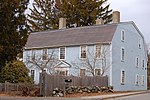Derby Summer House
Federal architecture in MassachusettsHouses completed in 1793Houses in Danvers, MassachusettsHouses on the National Register of Historic Places in Essex County, MassachusettsNational Historic Landmarks in Massachusetts ... and 1 more
Use mdy dates from August 2023

The Derby Summer House, also known as the McIntire Tea-house, is a summer house designed in 1793 by architect Samuel McIntire, now located on the grounds of the Glen Magna Farms, Danvers, Massachusetts. Since 1958 it has been owned by the Danvers Historical Society. A National Historic Landmark, it is significant as an extremely rare and well-preserved example of an 18th-century summer house, and also includes some of the earliest American sculpture in the carved wooden figures mounted on its roof.
Excerpt from the Wikipedia article Derby Summer House (License: CC BY-SA 3.0, Authors, Images).Derby Summer House
Maintenance Path, Danvers
Geographical coordinates (GPS) Address Nearby Places Show on map
Geographical coordinates (GPS)
| Latitude | Longitude |
|---|---|
| N 42.573211111111 ° | E -70.966202777778 ° |
Address
Maintenance Path
Maintenance Path
01937 Danvers
Massachusetts, United States
Open on Google Maps









